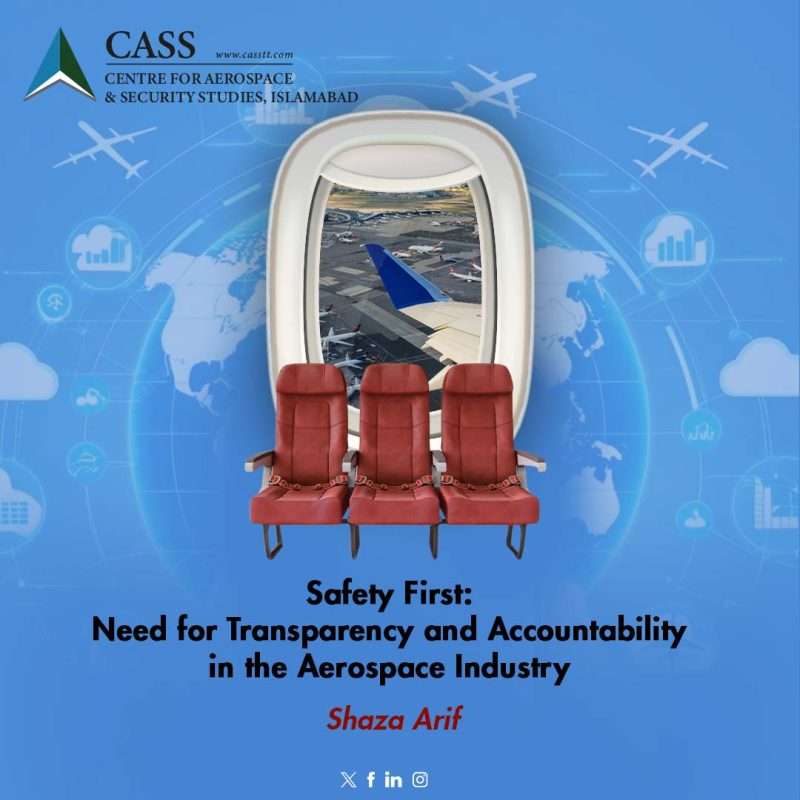Over the years, the aviation industry has witnessed a remarkable expansion in its operations and scope of activities. Advancement is marked with increasing innovation, technological breakthroughs and incorporation of state-of-the-art technologies. The sector has transformed commercial flying and has played a pivotal role in shortening physical boundaries, while simultaneously improving on-board passenger experience.
However, the aviation industry has been facing intense scrutiny due to a series of safety-related incidents, vis-à-vis both human factors and technical malfunctions. These issues have been on the rise over the past few years, with several alarming occurrences in the first half of 2024. For example, in January, Alaskan Airlines had to ground several of its 737 MAX 9 jets after one of its brand-new aircraft lost the outer section of the aircraft (exit door), leading to an emergency landing. It was shortly revealed that four critical bolts were missing, which led to the incident. Likewise, United Airlines reported that controls were jammed during the landing phase on a recently purchased 737 MAX in March. In the same month, LATAM Airlines had its Dreamliner plunged mid-flight, leading to several injuries as the pilot temporarily lost control. Other than these, multiple instances have occurred where the aircraft either lost or had its wheel burst off mid-flight or shortly after taking off. Other safety issues have also been flagged with the de-icing equipment on the 737 MAX and 787 Dreamliner aircraft, leading to concerns over engines losing thrust. Last week, a passenger aircraft crashed shortly after taking off, leading to the death of 18 individuals on-board.
These recurring safety incidents raise serious concerns regarding the regulations that are currently in practice in the aviation industry and the standards maintained by aircraft manufacturing companies. These incidents underscore the need for enhanced vigilance by domestic and international regulating authorities such as the Federal Aviation Agency (FAA), and the European Union Aviation Safety Agency (EASA), respectively. Regulators should enforce rigorous reassessment of certification processes, operational limitations, and safety regulations to prevent future occurrences and restore public trust in air travel. Such events also underscore the role of UN agencies such as International Aviation Civil Organisations (ICAO) which serve as the forum for states for international civil aviation. The agency is tasked to develop policies and standards, perform studies and analysis, undertake compliance audits and build aviation capacity via activities and cooperation of its member states. Furthermore, incidents related to air turbulence owing to climate change have also increased recently. The episodes of air turbulence (Air Korea, Singapore Airlines, Qatar Airways and Air Europa) and the resulting injuries hint that frequency of such occurrences could potentially increase in future. Given existing safety standards, their reoccurrence can lead to dangerous outcomes, potentially leading to a decline in overall confidence in flight safety.
The tragic crash in Nepal on 24th July of a Bombardier CRJ200ER also reflects a need to address underlying governance issues that compound the challenges faced by the industry. While different factors such as weather, navigation and inadequate regulations can contribute to such mishaps, it is pertinent to highlight the associated conflict of interest when the domestic aviation industry is operated and regulated under the same entity – as is the case with Nepal’s Civil Aviation Authority. In such scenarios, the authority is placed in a position of having to investigate itself when such issues surface, which impairs overall transparency. This suggests the pressing need to have operators and regulators under different entities to ensure flight safety.
Likewise, such incidents also raise considerable concerns regarding aircraft manufacturing companies, leading to several challenges. For instance, Boeing, an aerospace giant recently concluded its guilty plea agreement to criminal fraud conspiracy charge in connection with the two fatal crashes involving its 737 MAX jetliners. It is worth noting that Boeing is a major exporter of the United States, with export revenues standing at USD 77.8 billion. Taking action against Boeing would damage US dominance in the aircraft manufacturing industry and its export revenues. Such a move could shift market dynamics, with more airlines opting for rival Airbus, currently generating export revenues worth 65.45 billion Euros. It would also impact airline operations since both Boeing and Airbus already have considerable backlogs in aircraft delivery. In fact, Boeing has admitted that the aircraft deliveries scheduled for 2025 and 2026 might be encountering delays of three to six months. Hence, travel experience might also be affected due to pricing and route availability. It could also lead to supply chain disruptions and damage to airlines that rely on Boeing for its aircraft and maintenance; and put added cost and effort into the local maintenance of the airlines operating Boeing aircraft.
Recent air accidents raise serious concerns regarding the future of air travel and related industries. These episodes underscore the urgent need for enhanced transparency and accountability within the industry. It also calls for adhering to firm safety standards at all levels. Above all, it is crucial that aircraft manufacturers, operators and maintenance setups are subjected to a stringent independent regulatory oversight. It is crucial to prioritise human safety over the pursuit of technological dominance and profits, ensuring that the advancements in aerospace do not compromise passenger security.
Shaza Arif is a Research Associate at the Centre for Aerospace & Security Studies (CASS), Islamabad, Pakistan. The article was first published in Modern Diplomacy. She can be reached at [email protected].





